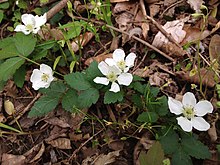Rubus flagellaris
| Rubus flagellaris | |
|---|---|

| |
| Berries and leaves | |
| Scientific classification | |
| Kingdom: | Plantae |
| Clade: | Tracheophytes |
| Clade: | Angiosperms |
| Clade: | Eudicots |
| Clade: | Rosids |
| Order: | Rosales |
| Family: | Rosaceae |
| Genus: | Rubus |
| Species: | R. flagellaris
|
| Binomial name | |
| Rubus flagellaris Willd. | |
| Synonyms[1] | |
|
Synonymy
| |

Rubus flagellaris, the northern dewberry,
Description
Rubus flagellaris has low-growing stems that range from 8–15 feet (2.4–4.6 m) long, and flowering stems that can grow up to 4 feet (1.2 m) in height. It can grow as a woody vine or low growing shrub. The young stems are green with a scattered arrangement of hairy prickles. The old stems are brown, woody and have hard prickles in comparison to the young stem. Sometimes the tips of the young stems root into the ground and form vegetative offsets.[3][4]
The species has its most active growth from mid-spring to early summer. The roots of the northern dewberry consist of a woody taproot.[3][4]
The plant has an alternate,
The plant produces a five-petaled white flower, each flower about one inch (25 mm) in diameter with five petals.
Once the flowers of the northern dewberry are fertilized, drupes soon grow and replace each flower.[3] The drupes are a dark-purplish color and range from ½ inch to one inch in diameter.[3][5] Once the fruit has fully ripened it has a tart-sweet flavor.[3][4]
Distribution and habitat
Rubus flagellaris is native to the central and eastern United States (from Texas, Oklahoma, Kansas, and Nebraska to the Gulf and East Coasts and the Great Lakes region), eastern Canada (Ontario, Quebec, New Brunswick, and Nova Scotia) and northern Mexico (Coahuila, Hidalgo, Nuevo León, San Luis Potosí, Sonora).[2][4][8]
Rubus flagellaris grows on dry soils, bogs, soft soils and wooded soils.
Rubus flagellaris is adapted to a precipitation zone that ranges from 15 to 40 inches/year, tolerates soils ranging from 5.0 to 7.0 pH, and can survive temperatures as low as −23 °F (−31 °C). This species has a low tolerance to drought conditions and an intermediate shade tolerance, when compared to other species with similar growth habits in its natural regions. The plant has no salinity tolerance.[2]
Ecology
Many animals such as raccoons, fox squirrels, eastern chipmunks, white-footed mice, and other mammals eat the northern dewberry's fruits, and aid in the dispersal of the shrub.[3] The plant has a high tolerance to hedging from livestock or wildlife browsing.[2]
The flowers of Rubus flagellaris, with a fragrant nectar, attract a large number of native bees. They also provide nesting materials and structures for the native bees.[9] Some of the bee species that interact with the plant and pollinate the flowers are mason bees (of the genus Osmia), leaf-cutting bees, cuckoo bees (of the subfamily Nomadinae), and miner bees.[3] Other insects that interact with the northern dewberry to help pollinate it are Siphonopora rubi (blackberry aphid), Metallus rubi (blackberry leafminer), Agrilus ruficollis (red-necked cane borer), and Edwardsiana rosae (rose leafhopper).[3]
The flowers are also a preferred source of nectar for the Karner blue, an endangered species of blue butterfly found in the Midwestern U.S. and northeastern North America.[10]
When occasional wildfires burn down tall woody trees surrounding Rubus flagellaris, the resulting burning has a positive effect on population growth for the species.[3] Other research has also shown that occasional wildfires are beneficial to the population's growth.[11]
Uses
The ripe berries are edible and can be eaten raw. They are also used to make preserves, pies, and cobblers.[12]
References
- ^ The Plant List, Rubus flagellaris Willd.
- ^ a b c d e f Natural Resources Conservation Service. "Rubus flagellaris Willd. − northern dewberry". Plants Database. United States Department of Agriculture (USDA). Retrieved April 29, 2015.
- ^ a b c d e f g h i j k l m n Hilty, John. "Common Dewberry". Wildflowers of Illinois in Savannas & Thickets. Retrieved April 29, 2012.
- ^ a b c d e f g Flora of North America, Rubus flagellaris Willdenow, 1809. Northern dewberry, ronce à flagelles
- ^ a b c Seiler, John; Jensen, Edward; Niemiera, Alex; Peterson, John (2011). "dewberry Rosaceae Rubus flagellaris Willd". Virginia Tech Department of Forest Resources and Environmental Conservation. Retrieved April 30, 2012.
- ^ a b "Family Rosaceae Rubus flagellaris Willd". Robert W. Freckmann Herbarium. Retrieved April 30, 2012.
- ^ "Rubus flagellaris - Willd". Plants for a Future. Retrieved April 30, 2012.
- ^ Biota of North America Program 2014 county distribution map
- ^ ‘’Lary Bird Johnson Wildflower Center’’, Rubus flagellaris Willd, April 30, 2012
- JSTOR 3083005.
- JSTOR 4034296.
- ^ "Wild Harvest: Texas' Bounty of Native Fruits|| TPW magazine|August/September 2013". tpwmagazine.com. Retrieved 2019-03-06.
